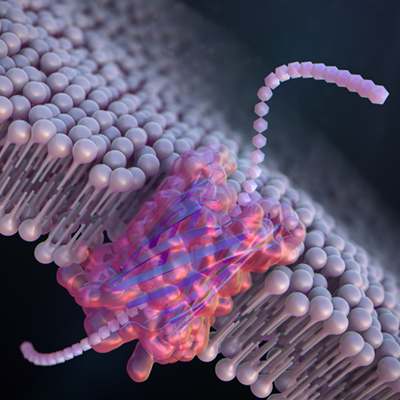April 27, 2023 -- University of Rochester Medical Center (URMC) researchers revealed a previously unrecognized player in the CRISPR system: a membrane protein that enhances anti-viral defense. The study, published Thursday in Science, broadens the current understanding of CRISPR's complexities.
Although CRISPR is known for its ability to edit genes quickly and accurately, CRISPR is basically an immune system that helps bacteria protect themselves from viruses by targeting and destroying viral DNA and RNA. CRISPR systems consist of two major components: a guide RNA that targets a specific viral DNA or RNA sequence and a Cas enzyme that cuts the targeted DNA or RNA, preventing the virus from replicating and spreading.
Researchers found that a specific Cas enzyme, Cas13, not only cuts viral RNA, but communicates with another protein, Csx28, to augment its antiviral defense. When they infected E. coli with a bacteria-attacking virus, called a phage, and then deployed the CRISPR-Cas13 system to target and halt infection, they found that Cas13 signaled Csx28 to affect membrane permeability. The Csx28 protein responded by forming a pore-like structure, creating a large hole. Csx28 was then able to wreak havoc in the infected cell, discombobulating membrane potential, hindering metabolism and energy production, and rendering the phage unable to replicate under such unhospitable circumstances.
CRISPR systems were previously thought to mount defenses only by degrading RNA and DNA in cells. Cas proteins such as Cas9 or Cas13 were thought of as the "big hammers" responsible for the damage. However, since the study indicates that Cas13 and Csx28 work together to effectively extinguish viruses, the researchers concluded that Csx28 enhances CRISPR-Cas13's phage defense.
The team is now using high-resolution cryo-electron microscopy to learn more about Csx28's structure and function. They found that Csx28 isn't active when Cas13 isn't around. They hope that understanding the biochemistry behind the opening and closing of the pore will shed light on how CRISPR-Cas13 uses it for defense and provide a jumping-off point for studying membrane proteins across other CRISPR systems.
"This finding is unexpected and raises all kinds of new questions about how bacteria protect themselves and what they do to survive infection," noted Mark Dumont, biochemistry and biophysics professor at URMC, in a statement. "It is also a very interesting interface between RNA biology, CRISPR, structural biology, and membrane biology. While there is no immediate medical relevance or application, the ideas that boil up from this could be very powerful."
"This pore-like protein doesn't resemble anything else we've seen before, and now that we know that this mechanism exists people will start to look for it in other systems," added John Lueck, assistant professor of pharmacology and physiology at URMC, in a statement. "This is exciting because in science, when you scratch the surface, you often find that there is an entirely new world behind it."
Copyright © 2023 scienceboard.net












